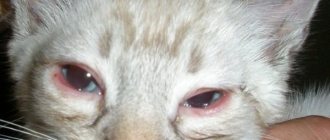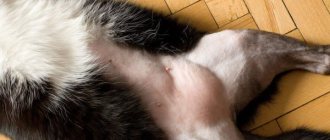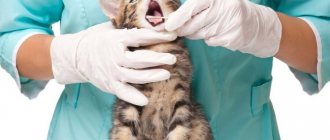Bad-smelling blood discharge from the cat’s genitals indicates the progression of diseases in the body, the causes of which are important to find out and eliminate as soon as possible. However, fluid from a cat’s vagina often appears as a result of natural physiological processes, for example, during estrus, before giving birth. In this situation, the discharge is transparent or light, without an unpleasant odor or other pathological inclusions.
Types and causes of occurrence
Physiological
When cats come into heat, a secretion is naturally released from the vagina, which is a signal indicating to the male that the female is ready to mate. Secretion can be observed within 2-3 days. During this period, the cat is especially affectionate, constantly rubbing against its legs, raising the back of its body, and arching its back. In this case, the secretion is released absolutely transparent, and any unpleasant odor is completely absent.
Discharge from the loop in cats can be observed during pregnancy, or more precisely, by the end of 3 weeks. During this period, a mucous plug forms in the cervix, which sometimes flows from the uterus, but its discharge is not abundant. At week 6, white or yellow discharge may appear from the vaginal passage. This is amniotic fluid leaking - a sign of impending labor. 2-3 days before the kittens are born, yellow or green mucus leaks out. This clot is a plug that, for natural reasons, is rejected immediately before childbirth.
During contractions, pink or red discharge appears. Brown clots are also normal. 2-3 weeks after lambing, cats may still have bleeding. In addition, yellowish and green inclusions are also acceptable, but their smell should not be unpleasant. During this period, it is important for the owner to constantly monitor the pet, especially if it is the first pregnancy.
Pus and blood from the vagina at any stage of pregnancy are a dangerous symptom, indicating pathology and the onset of inflammation. If the inflammatory process is not eliminated in a timely manner, the animal will die.
Pathological
Excessive bleeding in a cat indicates the development of the disease, so you should immediately consult a doctor.
Severe bleeding from a sterilized cat with the smell of rot can be a symptom of the progression of cancer localized in the kidney tissues or mammary glands. In this case, sexual activity may occur after sterilization, so the owner must urgently show the pet to a doctor. Bleeding and purulent vaginal discharge are often observed with the following diseases:
- Vaginitis. Inflammation of the vaginal walls, occurring in acute and chronic forms. The discharge is white at the initial stage, then it turns yellow. Brown clots indicate a bacterial infection.
- Pyometra. Inflammation of the uterus, which occurs in both young and old cats. The animal is bothered by heavy bleeding, and the inclusions may be red or brown, which in the latter case indicates an advanced process.
- Hematometra. With this disease, blood discharge is scanty. The main cause of the pathology is congenital anomalies, uterine fibroids, interrupted pregnancy, pathological or too frequent childbirth.
- Endometritis. Inflammation of the uterine wall, which often occurs after a difficult birth, accompanied by a delay in the release of the placenta. The result of such a deviation is infection of the organ, the development of complications and bleeding as a result.
- Urethritis. Inflammation of the urethra. With this disease, discharge from the urethra is observed in a cat or cat. If the disease is advanced, bloody and purulent inclusions with an unpleasant odor appear in the urine.
Discharge in a cat, which is a physiological norm
During heat, a cat secretes a clear fluid that goes unnoticed because the cat is constantly licking itself. Twenty days after mating, a pregnant cat secretes a little clear and thick mucus in her urine. This is part of the plug that clogs the cervix, necessary to protect the organ from infection.
In the sixth week of gestation, excess amniotic fluid is released. You need to be sure whether the cat is pregnant. If this is the case, then the release of a small amount of clear liquid is not a cause for concern.
A few hours before birth, white or yellowish discharge appears, sometimes slightly bloody. After the start of contractions, the amniotic fluid leaves, greenish or fawn, transparent.
Dangerous symptoms
If a cat’s blood is released from the vagina in clots due to the progression of dangerous disorders in the body, the following pathological symptoms will be additionally disturbing:
- decreased animal activity;
- loss of appetite or complete refusal of food and water;
- frequent or infrequent painful urination with blood;
- thorough licking of the anterior passage;
- increased body temperature;
- tachycardia, breathing problems.
Acute urethritis in a cat is accompanied by severe polyuria and irrepressible thirst. If the owner notices that blood or purulent fluid is flowing from under the tail, this symptom indicates the development of complications that cannot be dealt with without medical help.
A reason to consult a specialist!
In all of the above dangerous (!) situations, you should not risk the health of your tailed pet and “make a diagnosis” on Internet forums - “guess the tea leaves”, but it is better to consult with a veterinarian by toll-free phone, then make a house call or make an appointment , if required.
Then timely treatment will return the mustachioed and striped beauty to excellent health, and you will be in a good mood! And may it “never leave you again!”
Diagnostic methods
Diagnostic procedures include ultrasound examination of the abdominal organs.
If the bloody discharge in a young cat has a suspicious appearance and smells unpleasant, or if ichor with purulent inclusions leaks from the vagina, you should not hesitate to visit the doctor, otherwise complications cannot be avoided. At the initial appointment, the doctor will examine the animal, palpate the abdominal cavity, ask the owner about accompanying pathological symptoms, and also collect the necessary data that will help to understand why the animal is bleeding from the genitals.
The following diagnostic methods will help to establish an accurate diagnosis:
- general clinical analysis of blood and urine;
- biochemistry;
- microbiological study of a smear from the vagina and urethra;
- Ultrasound of the abdominal organs;
- radiography.
Treatment
Therapeutic measures are prescribed if it is determined that vaginal discharge is pathological. Depending on the diagnosis, the following medical techniques are used:
- Hemostatic therapy if a blood clotting disorder is established.
- Inhibition of the activity of pathogenic microflora. Antibiotic therapy.
- Extirpation of the uterus.
- Removal of tumors.
The use of steroidal antiphlogistic drugs is contraindicated. An attempt at self-medication poses a mortal threat to the pet, causing immediate death or provoking the formation of malignant tumors.
We invite you to join our Zen channel and group on VKontakte or Odnoklassniki, where new articles for pet owners are published.
Similar articles:
- My cat has a nosebleed - what should I do?
- Inflammation of the lower lip in a cat
- Clear nasal discharge in cats
How to treat pathology?
When brown, pink or white discharge appears in a cat due to natural causes, no special treatment is prescribed. If the owner does not intend to breed offspring, it is better to sterilize the pet. In a castrated cat, such problems disappear on their own. It’s another matter when blood flows from the genitals due to the progression of a dangerous disease. A treatment regimen that includes the following groups of drugs will help stop the disease:
An examination will help to cope with the situation, on the basis of which drug treatment will be prescribed.
- Hemostatic. Prescribed only by a doctor, they are used in cases where bleeding occurs without stopping due to a violation of the hematopoietic process.
- Antibiotics. They are used when there is pus with pathological ichor in the vaginal discharge, which indicates the addition of a bacterial infection.
Sometimes, with heavy bleeding, conservative therapy is powerless. Then the doctor decides to treat the pathology surgically. During surgery, defects that bleed are eliminated, as well as affected internal organs, including the uterus, are removed. After the operation, rehabilitation is carried out. Fluid may still be released from the genitals, so the animal must be under the supervision of a doctor who strictly monitors how recovery is progressing.
A cat has white uterine discharge: normal or pathological?
White genital discharge, if it is not associated with pregnancy or labor, is pus. Most often they occur due to decreased immunity as a result of the use of hormonal contraceptives or hormonal anti-inflammatory drugs.
Staphylococci are activated, which constantly live in the body and do not cause harm to health with a normally functioning immune system. Vaginitis develops.
Another cause of the disease is the consequences of mating with a cat infected with chlamydia, toxoplasma, feline immunodeficiency virus, and mycoplasma.
After a difficult birth, fragments of the placenta remain in the uterus, they fester, leading to endometritis. The most dangerous pathology that begins with white discharge is pyometra. The discharge becomes colored or stops. If additional symptoms appear - depression, pain in the enlarged abdomen, it means that pyometra has passed into the most dangerous - closed form. The pus does not come out, but accumulates inside the uterus.
In older animals, suppuration may be a symptom of a tumor process. The main reason for the occurrence of neoplasms is repeated hormonal disruptions caused by the termination of an unwanted pregnancy or the use of drugs to disrupt estrus.
First, a false pregnancy develops. The animal gets worried, begins to prepare the nest, and spoils the situation. She produces milk, but no kittens. Repeated imaginary tightness is dangerous because it triggers the process of development of neoplasms.
Be sure to read:
The cat's paw is swollen and he is limping: what to do, main causes, first aid, treatment methods
Prevention
If fluid drips from the organs of the genitourinary system for physiological reasons, but the animal is not planned to be mated, it is better to sterilize it to avoid pathological complications associated with hormonal surges. When a cat has a history of inflammatory and other diseases of the urinary system, it is recommended to periodically visit a veterinarian, do a preventive ultrasound, promptly treat internal diseases, do routine vaccinations, and if pathological symptoms develop, do not self-medicate, but find out the diagnosis as soon as possible and begin treatment. therapy under the supervision of a physician.
Treatment of white discharge in cats
If leucorrhoea is accompanied by an unpleasant odor, this is a reason to contact a veterinarian. After a clinical examination and laboratory tests, the doctor assesses the general condition of the cat and prescribes treatment. prescribes treatment.
With timely treatment, it is possible to use conservative therapy methods. Vaginitis or open pyometra is treated with douching. The cat owner should ask a veterinarian or experienced felinologist how this is done.
Medicines based on furatsilin or chlorhexidine are taken into a rubber syringe and carefully squeezed into the vagina. At the same time, oral antibiotics or sulfonamides are prescribed.
The radical method of treatment is castration. Indications: closed pyometra, cancer, age over 6 years. In Russia, castration is called sterilization, although these are different operations.
Residents of high-rise buildings get a cat, but do not know what to do with it when it reaches sexual maturity. The call of nature, not supported by mating, causes torment for the pet and those around her. A reliable way to prevent it is to remove the uterus with ovaries and appendages at 8-10 months.
In this case, the cat will never have white or differently colored discharge from the loop. The disadvantage is the need to use expensive specialized food for sterilized cats to avoid obesity.
How to help your pet
Loving owners always strive to help their pet. Whatever the methods, they must first of all be safe. If a cat is in heat, you need to encourage her natural urges and find a cat to breed. If you really don’t want your pet to have offspring, then you can “bring her back to her senses” with the help of special medications. For example, a special ointment that is applied to the nose every day. The animal will quickly return to its usual behavior and stop meowing loudly and chasing its owners.
Reference! If the discharge is not associated with estrus, then the best thing the owner can do is take the cat to the veterinarian, or call him at home (but if the disease is serious, then transportation to the clinic will be required).
The above diseases, after reading, should lead to the conclusion that the discharge indicates serious and dangerous diseases. Therefore, it is almost impossible to help your pet at home. Loss of appetite, baldness, deterioration in general condition and other dangerous symptoms cannot be “removed” on your own.











